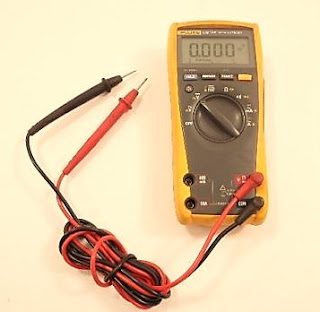Ohmmeter- an ohmmeter is used to measure resistance. Connected in parallel or across, It can be used to check and measure the continuity of the circuit . When using an ohmmeter it does not require correct application polarity.
Resistance test procedure:
the purpose of the Ω test is to measure the resistance or checking out if the circuit is short or open . Here are the procedures in performing a resistance test using both analog and digital multimeter(DMM)
For Analog multi-meter
1. Set the knob to ohm (Ω).
2. Check the pointer of the multitester if it is set to infinite.
3. Set the multi-tester to the desired range. You can set the pointer initially at zero Ω by connecting the two leads of the instrument and adjusting the knob to be exactly zero.
4. Measure the resistance of the component being measured. The reading is equivalent to the scale reading multiplied by the number indicated at the set range. Ranges are Ωx1, Ωx10 ,Ωx100, Ωx10k and Ωx1k
 For Digital multimeter (DMM)
For Digital multimeter (DMM)
1. Turn off power and discharge all capacitors of the circuit
2. Select "resistance" on the multimeter- You can switch to your designed ohm range position
3. Connect the test leads to the circuit to the device or circuit being measured
4 Read the resistance value on the digital display of the DMM
Resistance test procedure:
the purpose of the Ω test is to measure the resistance or checking out if the circuit is short or open . Here are the procedures in performing a resistance test using both analog and digital multimeter(DMM)
For Analog multi-meter
1. Set the knob to ohm (Ω).
2. Check the pointer of the multitester if it is set to infinite.
3. Set the multi-tester to the desired range. You can set the pointer initially at zero Ω by connecting the two leads of the instrument and adjusting the knob to be exactly zero.
4. Measure the resistance of the component being measured. The reading is equivalent to the scale reading multiplied by the number indicated at the set range. Ranges are Ωx1, Ωx10 ,Ωx100, Ωx10k and Ωx1k
 For Digital multimeter (DMM)
For Digital multimeter (DMM)1. Turn off power and discharge all capacitors of the circuit
2. Select "resistance" on the multimeter- You can switch to your designed ohm range position
3. Connect the test leads to the circuit to the device or circuit being measured
4 Read the resistance value on the digital display of the DMM
Note:
- Do not touch the pins (metal part) of the test lead t o avoid reading error caused by the resistance of the human body
- Don't make a resistance measurement while the circuit is with power. It may damage the meter by this improper operation
- for analog multimeter ,reset the pointer to zero when changing the range of the ohmmeter.
